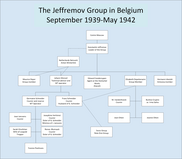Anton Winterink
Anton Winterink | |
|---|---|
 The committed communist, Anton Winterink, around 1940. | |
| Born | 5 November 1914 |
| Died | 5 July 1944 (aged 29) |
| Cause of death | Shot in Fort Breendonk |
| Nationality | Dutch |
| Occupation(s) | Communist agitator, agent |
| Organization(s) | Communist Party of the Netherlands, Red Orchestra |
| Known for | Resistance fighter |
Anton Winterink (5 November 1914 in Arnhem, 5 July 1944 in Brussels) was a Dutch Communist.[1] and a member of the Communist Party of the Netherlands. Winterink was a core member of an anti-Nazi Soviet espionage group in Belgium that came to be known as the Red Orchestra by the Abwehr. He worked as a radio operator for the Soviet espionage group's that was associated with the Soviet GRU officer, Konstantin Jeffremov, in 1940.[2] Winterink used the alias Tino to disguise his identity.[3] In late 1940, Winterink established an espionage organisation based in Amsterdam, that became known as Group Hilda that operated until early 1943. Winterink was arrested on 18 August 1942 by the Sonderkommando Rote Kapelle in Amsterdam. After being interrogated and involved in an attempt at Funkspiel, he was shot four months later at the Tir national military firing-range in Brussels.[4]
Life
Around 1938, Winterink met the artist Riek de Raat, at the home of De Raat's friend, Rita Storck.[5] Two years later, in 1940, the couple became life partner's.[5][6] After the General strike of 1941, Riek de Raat and Winterink moved in together,[5] hiding at their house at 8 Oude Looierstraat.[5]
Career
In 1933, Winterink was one of three officials that ran the Netherlands branch of the International Red Aid, a social organisation that helped displaced communists with food and accommodation.[7] At the time, Winterink and many others members of the CPN were involved in raising aid money to buy food and clothing for communist refugees from Germany.[8] In the 1930s, Winterink was an important functionary of Rote Hilfe in the Netherlands.[9]
In late 1936 or early 1937 (sources vary), Soviet
Arrest
On 18 or 19 August 1942 (sources vary), Winterink was arrested[14][15] by the Gestapo rom the Sonderkommando Rote Kapelle, at a cafe in Amsterdam.[15][16] Nine members of the group with two remaining radio transmitters were never discovered and continued to work. A total of 17 people from Winterink's group were arrested. Winterink was sent to a prisoner-of-war camp (Kriegs Wehrmacht prison) in Brussels, before being sent to Fort Breendonk.[15] He was interrogated and tortured for two weeks by the Sonderkommando in Brussels, after which he agreed to work for the Abwehr.[17] Winterink took part in a Funkspiel operation. His radio station, that was known as Beam Tanne, began transmitting in September 1943.[18] In March 1944, Winterink's Funkspiel operation was abandoned. The German funkspiel operation was largely a failure.[19] Four months later on the 5 July 1944,[15] Winterink was shot at the Tir national firing-range in Brussels.[4] where he was buried anonymously. The grave site is single grave 312 in row II.
Bibliography
- Perrault, Gilles (1990). Auf den Spuren der Roten Kapelle (in German) (Revised, New ed.). Wien: Europaverl. OCLC 75468124.
- Trepper, Leopold (1978). Die Wahrheit Autobiographie ; mit 24 Bilds. u. zahlr. Dokumenten im Anh. dtv, 1387 (in German) (Ungekürzte Ausg ed.). München: Deutscher Taschenbuch-Verlag. p. 371. OCLC 74449504.
- Coppi Jr., Hans (July 1996). Dietrich Bracher, Karl; Schwarz, Hans-Peter; Möller, Horst (eds.). "Die Rote Kapelle" [The Red Orchestra in the field of conflict and intelligence activity, The Trepper Report June 1943] (PDF). Quarterly Books for Contemporary History (in German). 44 (3). Munich: Institute of Contemporary History. ISSN 0042-5702. Archived from the original(PDF) on 18 May 2015. Retrieved 11 January 2022.
- Колпакиди, Александър (2001). Империята ГРУ [Imperium GRU] (in Bulgarian). TRUD Publishers. p. 216. ISBN 978-954-528-267-6.
References
- ISBN 978-0-8108-6421-4.
- ^ Kesaris 1979, p. 388.
- ^ a b c Kesaris 1979, p. 66.
- ^ ISBN 978-1-4331-0581-4.
- ^ a b c d Milikowski, E. (December 2015). "De Vriendenkring". Spanje 36 – 39 (in Dutch). Retrieved 5 February 2022.
- ^ Compas, Christa (15 October 2018). "In Memoriam Riek (H.G.) Milikowski-de Raat". Humanistisch Verbond (in Dutch). Amsterdam. Retrieved 11 January 2022.
- ISBN 9780817984014.
- OCLC 71392888.
- ISBN 978-1-4331-0581-4.
- ^ a b Kesaris 1979, p. 383.
- ^ a b c Kesaris 1979, p. 67.
- ISBN 978-5-7654-1499-6.
- OCLC 1044472.
- ^ Kesaris 1979, p. 389.
- ^ a b c d "30480 Inventory of the archives of Riek Milikowski-de Raat". Het Stadsarchief Amsterdam (in Dutch). Retrieved 21 April 2022.
- ISBN 3-423-01387-7.)
{{cite book}}: CS1 maint: location missing publisher (link - ^ Kesaris 1979, pp. 68–69.
- ^ Kesaris 1979, p. 61.
- ^ Kesaris 1979, pp. 111–116.
Sources
- Kesaris, Paul. L, ed. (1979). The Rote Kapelle: the CIA's history of Soviet intelligence and espionage networks in Western Europe, 1936-1945. Washington DC: University Publications of America. ISBN 0-89093-203-4.



